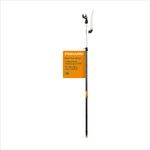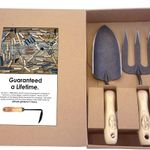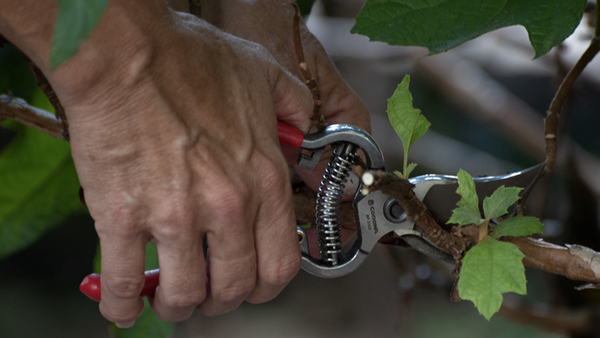
Friends don’t let friends prune without a reason. If you are pruning without a clear idea of why, put down the pruners and walk away from the plant. Trees and shrubs lived on this planet long before people devoted valuable time to cutting off their limbs, and they will be here for years and years after we are gone. It is true that some cutting may help a plant’s health, but it is equally true that if you don’t know what you are doing and why you are doing it, then you are more likely to hurt the tree or shrub than help it. Here are some basic principles behind the practice of pruning and a few simple instructions to help you make the right cut when pruning is needed. If you don’t have the time or patience to pull out a textbook every time pruning is actually necessary, the following tips should help you make good pruning decisions without having to do hours of research first.
Dive deeper into the art and science of pruning in our Pruning Project Guide
When to Prune
- Brown = Dead, damaged, and diseased
- Yellow = Summer bloomers
- Pink = Spring bloomers
- Green = Evergreens
Let’s get something straight right off the bat. The safest time to prune any woody plant is in the very early spring or late winter after the fear of a hard frost is gone. At this time most diseases that could infect a cut stem are dormant, giving the plant a chance to heal before any infection can set in. If you are only pruning once a year, this is the time to do it. If you want to ensure a better floral display, then you should time the maintenance pruning according to when your woody plants flower. For more help on determining the best timing, check out the flow chart below.
3 Reasons to Prune
Pruning is sometimes done without a clear objective; you might just be doing it because you are “supposed” to. While there are many nuances to the practice, the grounds for doing so generally fall into three categories. If you are a little murky as to why you are pruning (or if you could use a refresher), hit the pause button and consider these reasons first.
1. Control damage and prevent hazards

Dead, damaged, and diseased branches or stems (pictured) are hazardous to your woody plants and potentially to you and other people. When a plant is injured (for whatever reason), it is under stress and vulnerable to more problems. Think of injury as a welcome mat for pests and diseases to set up shop and spread. And if we are talking tree limbs, the problem can also be dangerous for people and property. Limbs fall, and when they do, they can fall with sufficient force to kill or maim people or to damage houses. Do not hesitate to remove dead, damaged, or diseased limbs, branches, and stems as soon as you notice them. This is the most important rule of pruning. In the case of large or difficult-to-access limbs, however, have a professional remove them for you.
2. Manage habit or guide growth

This is the place where many people go wrong when pruning. Plants have a particular way they want to grow. Choosing a plant that will naturally fit the space you want to fill is important. Generally speaking, pruning is a way to gently guide and accentuate the natural form of a plant, not to make it into something it is not. Periodically pruning to remove an oddball wayward branch or stem, to refresh a wild or tired shrub, or to limb up and showcase beautiful tree-trunk structure or bark is a handy way to tweak growth to your advantage. But if you find yourself in a constant battle to keep your plant’s size in check (pictured), you don’t need pruners—you need to plant a different tree or shrub. The exception to that advice, of course, is if you have committed to having a labor-intensive hedge, topiary, or some other high-maintenance feature.
3. Improve plant health, vigor, and production

Many woody plants grow better if they are periodically pruned. This type of maintenance or rejuvenation pruning allows additional light transmission into the canopy and interior growth, improves air circulation (which reduces the chances of disease), and results in the plant directing its resources to the branches and stems that remain after it has been pruned. In many instances, selectively and judiciously removing some old growth in order to stimulate fresh, new growth can transform an old, tired-looking plant (pictured) into a garden centerpiece and increase flower production (on flowering plants). Likewise, this type of pruning can revitalize the growth of shrubs and canes and boost fruit production of fruit trees.
Rules to Prune By
Though you can find all kinds of rules on the internet and in books for how to prune, there are some fundamental techniques and strategies that will give you a solid starting place. From exactly where to make cuts to choosing the right tool for the job to ways of approaching maintenance pruning, consider or refamiliarize yourself with these tips the next time you need to prune. And if you find you have made a pruning blunder, do your best to correct it (if possible); however, don’t fret too much, and learn from your mistake. Most healthy plants are incredibly forgiving and can recover in time.
Make well-placed branch and limb cuts to prevent problems later
Leave no stub.
When pruning small branches or stems, avoid cutting in the middle of the branch/stem and leaving a stub. Stubs are unattractive and will likely die, leaving an entry point for diseases and insects. Instead, cut back to a healthy bud (A), a lateral branch (B), or the main trunk (C)—or to the ground in the case of multistem shrubs. Cutting back to a bud will lead to new stems growing around the cut (from the nearby buds). If that is not desired, it is best to remove the branch or stem entirely.
Keep the branch collar.
When you are fully removing tree limbs, avoid flush cutting—the practice of removing the branch collar. A flush cut leaves more of the tree’s vascular system exposed, which allows diseases to enter the tree more easily. A flush-cut wound will also close more slowly and leave a larger scar than a cut made at the branch collar. You don’t want to leave an unsightly stub either; cutting just outside the branch collar is the best location to place the final cut.
Maintenance prune in two ways to rejuvenate multistem shrubs
Thin to retain functionality.
Over time, older multistem shrubs can become unproductive and appear unattractive with an abundance of large, crowded stems and dense twiggy growth. The safest way to rehabilitate your shrub while retaining its basic shape and functionality in your garden is to thin it. Do so by removing about a third of the shrub’s major stems per year over the course of three years. The cuts should be made about 6 inches to a foot from the ground and right above a bud if possible.
Chop for a fresh start.
Old, run-down, and unsightly multistem shrubs may be able to be rehabilitated using a more aggressive approach—a full chop or removal of all the stems back to about 6 inches from the ground. It sounds scary, but you will be surprised by how quickly your shrub rebounds by sending up new, more vibrant stems. However, be aware that, although it happens rarely, some shrubs may be too weak to rebound.
Choose the right tool for the job
As with all aspects of gardening, there is an array of tools available for pruning. Choosing the right blade for the job will make the task much easier. Here are some general rules of thumb for choosing your cutting implement. It is also a good idea to check the manufacturer’s specs for the size branches a particular tool is designed to cut.

- Hand pruners are great, but even the best hand pruners can only handle limbs up to about ¾ inch in diameter, and for those without Popeye-like forearms, or in the case of extremely dense woods, even that may be a stretch.
- Loppers tackle larger limbs up to about 2 inches in diameter; after that it is time to use a handsaw.
- Hand saws and folding saws are excellent choices for making quick work of smaller branches and limbs 2 to 3 inches in diameter.
- Bow saws, often the tools of choice in holiday tree fields, can cut through the trunk of a conifer in a jiffy. But if you have a lot more than that to cut, you will likely want something with power.
- Chainsaws are great for tackling a lot of large limbs, but really big jobs are best left to professional arborists.

Determining When to Make the Cut
If you find that all these pruning rules are tough to keep straight, ask yourself the following questions.

Deciduous spring bloomer (or blooms on old growth)These woody plants bloom in spring or early in the first half of the gardening season from flower buds that formed in the previous year. They are best pruned right after flowering to ensure that new growth that appears after pruning this season will produce blossom buds for next year. Plants that fall into this category include the following:
|
Deciduous summer bloomer (or blooms on new growth)These woody plants bloom in summer or late in the second half of the gardening season from flower buds that formed in the current year. They are best pruned in late winter or early spring before new growth (which produces the current year’s blooms) appears in spring. Plants that fall into this category include the following:
|
EvergreenThis is a complex group. Conifers rarely, if ever, need maintenance pruning. Broadleaf and narrow-leaf evergreens may require an occasional snip in spring after the threat of frost has passed (nonflowering plants) or after blooming (flowering plants). Plants that fall into this broadleaf and narrow-leaf category include the following: Prune after last spring frost
Prune after flowering
|
*Invasive Alert:
Rose of Sharon (Hibiscus syriacus)
This plant is considered invasive in TN and WV.
Please visit invasiveplantatlas.org for more information.
Jeff Gillman, Ph.D., a Fine Gardening contributing editor and the author of The Truth About Organic Gardening, is the director of the University of North Carolina Charlotte Botanical Gardens.
Illustrations: Jessica Daigle
Find more pruning tips:
Five Common Pruning Mistakes, and How to Fix Them
Fine Gardening Recommended Products

ARS Telescoping Long Reach Pruner
Fine Gardening receives a commission for items purchased through links on this site, including Amazon Associates and other affiliate advertising programs.

Fiskars 7.9-12ft Extendable 2-in-1 Pole Tree Trimmer & Pruner with Rotating Head and Precision-Ground Steel Saw Blade
Fine Gardening receives a commission for items purchased through links on this site, including Amazon Associates and other affiliate advertising programs.

Dewit 3-Piece Tool Gift Set with 3-Tine Cultivator, Forged Trowel and Forged Hand Fork
Fine Gardening receives a commission for items purchased through links on this site, including Amazon Associates and other affiliate advertising programs.

































Comments
Log in or create an account to post a comment.
Sign up Log in